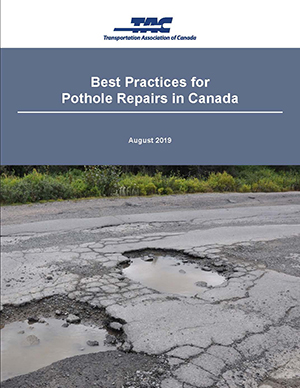This article was originally published in August 2019. Updated April 2023.
 To help Canadian road authorities tackle this challenge, the Transportation Association of Canada (TAC) has released its much-awaited Best Practices for Pothole Repairs in Canada. This new publication looks at current approaches to fixing potholes in Canada, and at effective techniques used by domestic and international agencies. It recommends strategies for short-term and long-term patching in all seasons, and discusses how to evaluate and select patching products for common road surfaces. Finally, it provides a series of recommendations and best practices for agencies to consider.
To help Canadian road authorities tackle this challenge, the Transportation Association of Canada (TAC) has released its much-awaited Best Practices for Pothole Repairs in Canada. This new publication looks at current approaches to fixing potholes in Canada, and at effective techniques used by domestic and international agencies. It recommends strategies for short-term and long-term patching in all seasons, and discusses how to evaluate and select patching products for common road surfaces. Finally, it provides a series of recommendations and best practices for agencies to consider.
The guide is available in print and e-book formats through TAC’s online bookstore, at a cost of $99 for TAC members or $129 for non-members. A 5-page free primer on the topic is also available.
A webinar recording on the contents of the synthesis of practice is available. The webinar was originally presented on September 12, 2019.
----------------------------
Issue
The repair of potholes throughout a road network is a costly and problematic challenge for Canadian road agencies. Pavements often develop potholes during winter and spring thaw conditions, when it is difficult to obtain quality patching materials. Repair strategies applied by most Canadian agencies are typically reactive, with the patching of distress locations temporary, until more favourable weather conditions permit a more permanent solution.
In recent years, there have been a number of patching products offered to agencies, with many Canadian agencies struggling to obtain appropriate information about the products, installation procedures, and the long-term performance that can be expected. Since most of the products are proprietary in nature, there can be significant issues with understanding the causes of problems or failures that may occur. To assess the topic and provide guidance to agencies, TAC’s Soils and Materials Standing Committee initiated the study.
Scope
The publication identifies current Canadian road authority practices with respect to pothole repair, outlines best practices from both Canadian and international agencies, and provides recommendations to manage and minimize the occurrence of potholes.
Acknowledgments
The publication was developed for TAC by Applied Research Associates, with funding from partners including Manitoba Infrastructure; Ministère des Transports du Québec; New Brunswick Transportation and Infrastructure; Newfoundland and Labrador Transportation and Works; Northwest Territories Department of Infrastructure; Prince Edward Island Transportation, Infrastructure and Energy; Saskatchewan Ministry of Highways and Infrastructure; Yukon Highways and Public Works; and the cities of Calgary, Edmonton, Montréal, Ottawa, Saskatoon and Winnipeg.
What are potholes?
Potholes are the result of small area defects or deterioration in the pavement that may require reactive emergency repair, followed by more substantial semi-permanent repairs when weather conditions improve. Potholes can occur in all types of pavement sections.
What causes potholes?
Potholes have multiple causes including age and condition of the pavement, environmental conditions, traffic type and frequency, moisture sensitivity, and construction defects, as well as lack of funding for preventive maintenance treatments and timely rehabilitation of aging infrastructure.
How are potholes repaired?
The most common temporary repairs are throw-and-go and throw-and-roll methods. Throw-and-go is the most common method used in pothole repair campaigns and involves filling the pothole with material and having traffic compact it. Throw-and-roll is similar to throw-and-go with the exception that the pothole is compacted by truck tire before the crew moves to the next pothole. Semi-permanent repairs yield better results, but are more expensive and take more effort to complete a repair.
What material is used to repair potholes?
The most popular pothole repair patching material used in Canada is cold applied emulsion based products, followed by hot mix asphalt.
When do pothole repairs take place?
Weather conditions, public complaints and resources available are the main factors deciding whether temporary or semi-permanent repairs are required. Temporary repairs are usually made during poor weather conditions that are not optimal for more permanent repairs. Semi-permanent repair is normally done during favourable weather conditions and may require removal of deteriorated pavement and loose material around the repair area. Cold mix is generally used for temporary repairs with hot mix used to finish the repair.
Potholes are usually repaired in live traffic conditions. A typical pothole and patch repair crew consists of two to five people and depends on the location, scope of work and equipment.
What are the recommendations in Best Practices for Pothole Repairs in Canada?
Best Practices for Pothole Repairs in Canada recommends temporary and long-term patching strategies for different seasons, as well as for evaluating and selecting patching products that will lead to improved performance of asphalt and chip seal roadways. It also provides recommendations for communication, performance measurement and training practices.
Where can I access more information?
Best Practices for Potholes in Canada can be purchased in TAC’s online bookstore. A free primer, based on the publication, is also available.